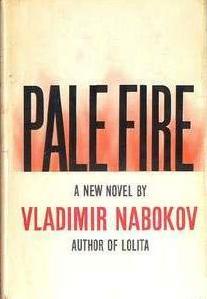
Back نار شاحبة Arabic Fahles Feuer German Pálido fuego Spanish آتش کمفروغ Persian Kalvas hehku Finnish Feu pâle French Գունատ կրակը Armenian Fuoco pallido Italian 青白い炎 Japanese 창백한 불꽃 Korean
 First US edition of Pale Fire | |
| Author | Vladimir Nabokov |
|---|---|
| Language | English |
| Publisher | G. P. Putnam's Sons |
Publication date | 1962 (corrected edition first published by Vintage International, 1989) |
| Publication place | United States |
| Pages | 315 |
| OCLC | 289702 |
Pale Fire is a 1962 novel by Vladimir Nabokov. The novel is presented as a 999-line poem titled "Pale Fire", written by the fictional poet John Shade, with a foreword, lengthy commentary and index written by Shade's neighbor and academic colleague, Charles Kinbote. Together these elements form a narrative in which both fictional authors are central characters. Nabokov wrote Pale Fire in 1960–61, after the success of Lolita had made him financially independent, allowing him to retire from teaching and return to Europe.[1][2] Nabokov began writing the novel in Nice and completed it in Montreux, Switzerland.[3]
Pale Fire's unusual structure has attracted much attention, and it is often cited as an important example of metafiction,[4][5] as well as an analog precursor to hypertext fiction, and a poioumenon.[6] It has spawned a wide variety of interpretations and a large body of written criticism, which literary scholar Pekka Tammi estimated in 1995 as more than 80 studies.[7] The Nabokov authority Brian Boyd has called it "Nabokov's most perfect novel",[8] and the critic Harold Bloom called it "the surest demonstration of his own genius ... that remarkable tour de force".[9]
- ^ Boyd, Brian. "Shade and shape in pale fire". www.libraries.psu.edu. Archived from the original on 2021-09-30. Retrieved 2021-09-30.
- ^ Walter, Brian. "Synthesizing artistic delight: the lesson of pale fire". www.libraries.psu.edu. Archived from the original on 2021-07-06. Retrieved 2021-09-30.
- ^ Roth, Matthew (2015). "THE COMPOSITION OF NABOKOV'S PALE FIRE" (PDF). Nabokov Online Journal. IX. Archived from the original (PDF) on 2023-04-22. Retrieved 2021-09-30.
- ^ McCaffery, Larry (1982). The Metafictional Muse: The Works of Robert Coover, Donald Barthelme, and William H. Gass. University of Pittsburgh Press. p. 21. ISBN 0-8229-3462-0. Retrieved 2009-09-18.
- ^ Waugh, Patricia (January 1984). Metafiction: The Theory and Practice of Self-Conscious Fiction. Methuen & Co. pp. 15, 85. ISBN 0-416-32630-7. Retrieved 2009-09-18.
- ^ Fowler, Alastair (1989). The History of English Literature. Cambridge, Massachusetts: Harvard University Press. p. 372. ISBN 0-674-39664-2.
- ^ Tammi, Pekka (1995). "Pale Fire". In Vladimir E. Alexandrov (ed.). The Garland Companion to Vladimir Nabokov. Garland Publishing. pp. 571–585. ISBN 0-8153-0354-8.
- ^ Boyd, Brian (2002). "Nabokov: A Centennial Toast". In Jane Grayson; Arnold McMillin; Priscilla Meyer (eds.). Nabokov's World. Volume 2: Reading Nabokov. Palgrave. p. 11. ISBN 0-333-96417-9.
- ^ Bloom, Harold (2003). Genius: A Mosaic of One Hundred Exemplary Creative Minds. Grand Central Publishing. ISBN 0-446-69129-1.
© MMXXIII Rich X Search. We shall prevail. All rights reserved. Rich X Search